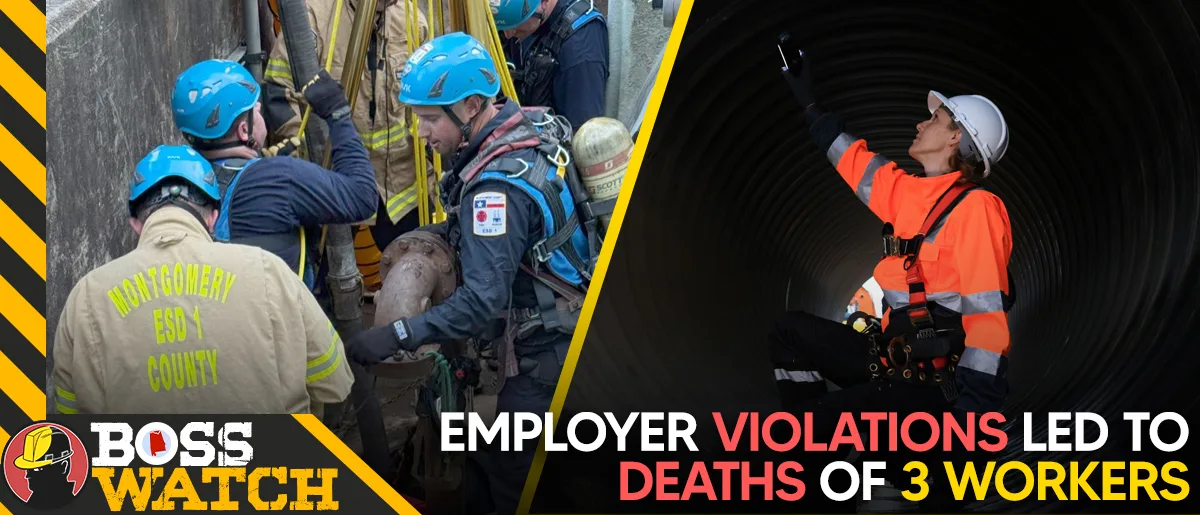Illegal activities of Southern Bosses for the weeks between Friday, September 5, and Friday, September 12
Texas Killers
From Jordan Barab’s Confined Space newsletter:
Three workers died in a manhole in Trinity, Texas, Wednesday night after two rescuers were overcome climbing into a manhole filled with sewage to rescue the original worker. All three died.
Trinity County Chief Deputy Jeremy Carroll described what happened.
The men were working on a lift station, which moves the sewage through pipes.
“So the crews, from what we gather, were not sent to work on any issues or any underground issues. They were simply working on the motor for the lift station,” Carroll said.
While completing their assigned job, Carrol said one man went into the manhole to stop sewage from backing into their work area. He said the worker fell unconscious and another went to help him. Then the third went in to try to save the other two.
“At that point the gas overcame him as well, with his alarm going off on his gas meter which said H2S, which is hydrogen sulfide gas,” said Carroll.
Carroll said they did not recover all three bodies until after 6:30 p.m.
The manhole was contaminated with toxic hydrogen sulfide gas which is a well-known naturally occurring byproduct of decomposing sewage. OSHA warns that high concentrations of hydrogen sulfide can cause “rapid unconsciousness, ‘knockdown’ or immediate collapse within 1 to 2 breaths, breathing stops, death within minutes.”
The three workers were identified as John Nelson Sr, Bradley Wrightsman, 46, and Brad Hutton, 47 of Willis.
Multiple deaths in confined space incidents were once common — before OSHA issued its General Industry Confined Space standard in 1993. One worker goes down into an unmonitored, unventilated confined space and passes out from hydrogen sulfide or oxygen deprivation. His buddy sees him, and jumps in to help him. He is overcome, and his buddy sees him and repeats the deadly process. Over and over again until someone figures out that rescue attempts are likely death sentences.
NIOSH’s 1979 “Criteria for a Recommended Standard: Working in Confined Spaces” reported that in cases surveyed, far more rescuers had died than initial victims.
Manholes are well-recognized locations of hydrogen sulfide — either from rotting sewage or other organic material. OSHA has had a confined space standard on the books since 1993 which protects sewage workers if the employer complies with the requirements of the standard.
The OSHA standard requires confined spaces to be tested for toxic gasses or oxygen shortage before workers enter and ventilated if gasses are detected. There must be an attendant up top who is in communication with the entrant, and there must be a means of non-entry rescue; which means that there must be a way to remove the worker from the space without a rescuer entering. This is usually done using a winch attached to the entering worker. Workers must also be trained on how to prevent injuries and deaths in confined spaces and a “permit” must be completed before entry that assures that all safety measures have been implemented.
Two of the three workers were employed by H2O Innovation and one worked for Hydroclear Services.
Frédéric Dugré, the President and CEO of H2O Innovation said “Our thoughts and prayers go out to the families and loved ones of the three people who lost their lives.”
H2O Innovation is a Canadian company with over 1100 employees that does water, wastewater, and water reuse treatment for municipal and industrial customers in Canada and 15 states.
Earlier this year, the company was cited for violations of OSHA’s respirator and Hazard Communication standards. In 2021, H2O Innovation received a $75,000 citation (later reduced to $37,549) for trenching violations, including one “repeat” violation. The company had also cited for two trenching violations earlier in 2021. The penalty for those violations was $27,306, later reduced to $19,114.
Union Busters
Brought to you by LaborLab: The nation’s leading watchdog standing with working families to stop employer coercion and intimidation. Visit www.laborlab.us for more info.
Here are the new filings from this week:
- Integra Healthcare Equipment (IL) hired Independent Center for Worker Education for $3,750/day
- Tessenderlo Kerley, Inc (AZ) hired GRCA
- Workers won the union election 17-2
- Union busters didn’t file until after the election
- Republic Services (CA) hired Action Resources for $3,950/day
- Marcus Hotels, Inc. dba Hilton Madison Monona Terrace (WI) hired Action Resources for $3,950/day
- Workers won the union election 43-22
- Union busters didn’t file until after the election
As a reminder, due to a lack of enforcement, some labor relations consultants may disregard the law and fail to report their activities to the U.S. Department of Labor. Therefore, it’s crucial for organizers and workers to report suspected “persuader” activity to the U.S. Department of Labor’s Office of Labor-Management Standards (OLMS).
It’s crucial for organizers and workers to report suspected “persuader” activity to the U.S. Department of Labor’s Office of Labor-Management Standards (OLMS). You can reach them via email at OLMS-Public@dol.gov, by calling (202) 693-0123, or by contacting your nearest OLMS District Office.
For assistance, please contact LaborLab at contact@laborlab.us.
